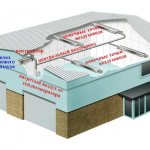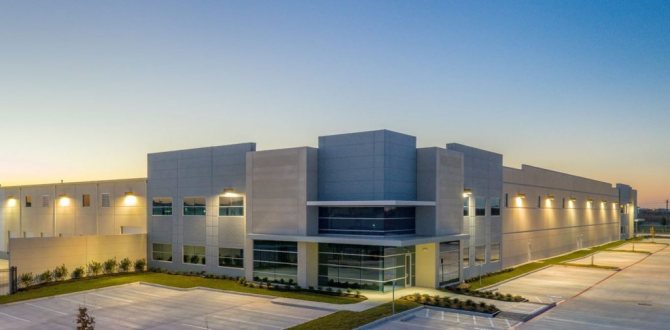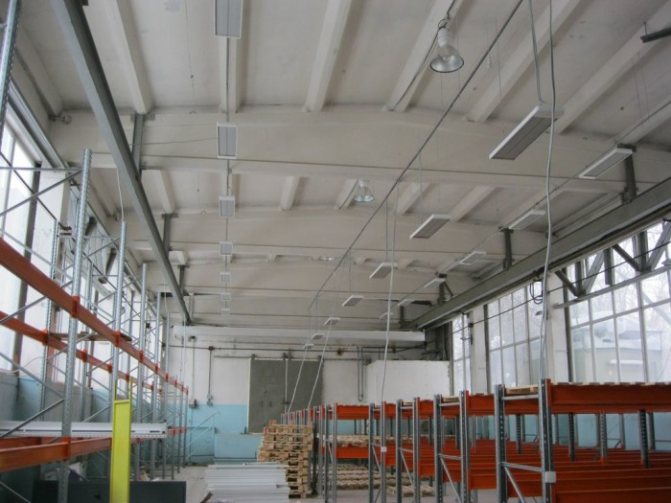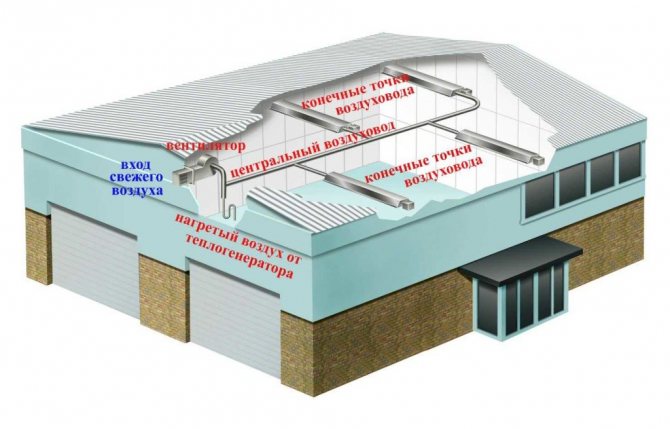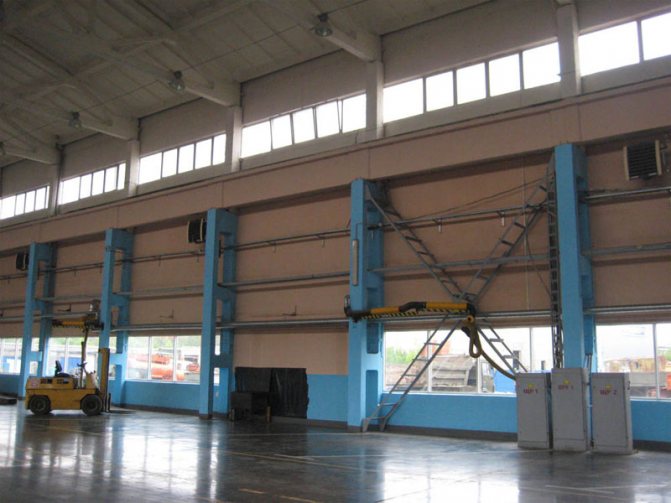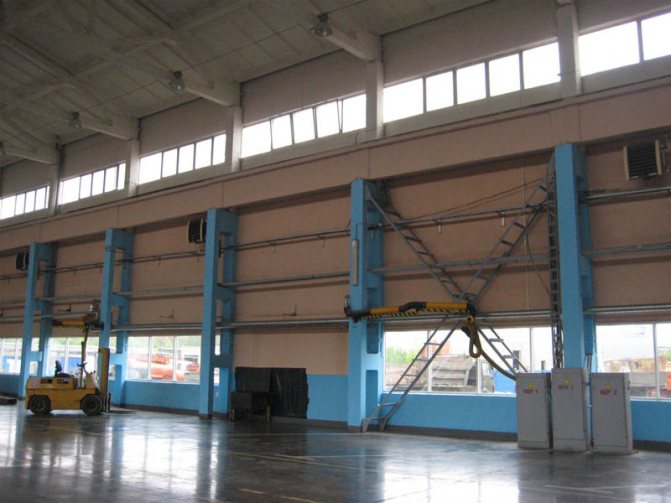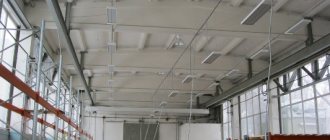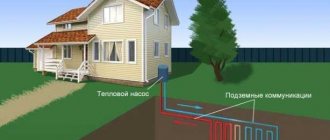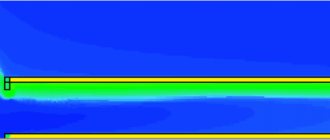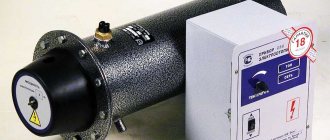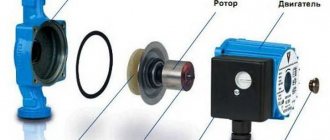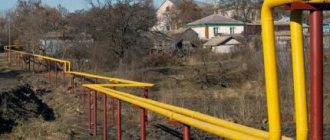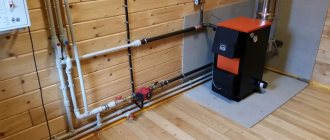- Room characteristics
- Thermal insulation of warehouses and hangars
- Warehouse heating methods
- Air heating systems
- Radiant heating systems
- Air-thermal curtains
- Water infrared panels
Send a quick request Heating of warehouses, hangars, storage facilities and other similar buildings differs significantly from heating, say, residential buildings - both the overall dimensions of the room and the special requirements for the conditions of the internal microclimate play an important role.
INTECH-Klimat is ready to implement professional solutions for climatic and other engineering equipment. We will carry out a full cycle of turnkey works: design, selection, delivery, installation and maintenance. Call now: +7
... Submit your application
In particular, it is usually required to heat not the entire warehouse, but only certain working areas and places of cargo storage, moreover, the temperature and humidity level in such areas can be completely different. In this regard, the issue of heating the warehouse must be approached with the utmost responsibility - in order to be able to fully use the functionality of the premises.
Standard water heating, with which any of us are well familiar, is of little use for heating air in such a spacious room - the heated air masses will simply rise up into unused areas. Accordingly, costs will rise significantly - with minimal useful return. So, what kind of warehouse heating system should you use?
Room characteristics
When choosing a heating system, you should pay attention to some characteristics of the building. First of all, it is necessary to take into account the height of the ceiling and the area of the building. If the height from floor to ceiling is more than 3 m, then it is not recommended to use water systems, because they are unable to provide the required temperature in large rooms.
The second important indicator is thermal insulation. Insulated walls and ceiling will significantly save money spent on heating a workshop or warehouse. If it is not possible to avoid heat loss, it is recommended to use heat sources that heat certain work areas.
You should also take into account the technological temperature requirements for the storage of raw materials or products.
Design and installation of a heating system for a warehouse and workshop
The task of any warehouse is to provide the manufactured and other products with all the conditions that are so necessary to preserve the qualities specified in their manufacture. In this case, the general nuances of the microclimate of the warehouses, set by the degree of heating, the level of ventilation and humidity, matter. The role of heating is presented as the effective maintenance of the correct temperature in warehouses during the cold season, since it is during this period that low-temperature influences lead to freezing of liquids, fragile products, damage to goods in the warehouse of biological materials.
Heating options
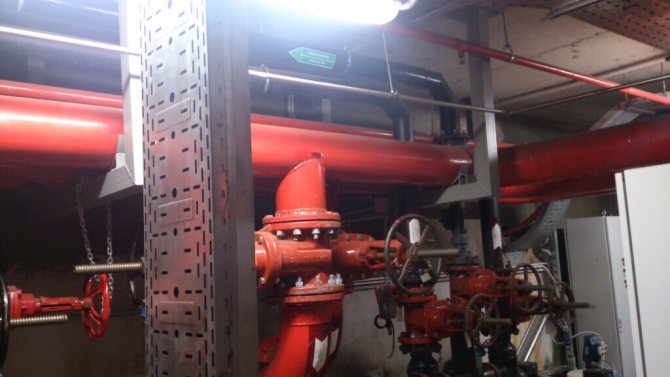
The criteria for choosing a heating system for warehouses, workshops are presented in technological standards and requirements specified by the sanitary-hygienic and fire-fighting department. The following types are distinguished:
- Centralized, assuming the location of the sources of the system outside the premises. They can be presented with air, steam, water or combined type of heat transfer media.
- The forced heating circuit of warehouses, for the distribution of heat, contains in its configuration a system of pumps and fans.
- Natural heating assumes the circulation of the heat flow in natural ways.Natural heating of a warehouse or similar premises is carried out according to the principle of heat exchange between air or water heat carriers.
The designation criteria and the established degree of safety can assume its own heating option for each room.
Heating system selection rules
You can get good heating by choosing the right type of heating. Each parameter of the building is taken into account here, which include:
- the area of the heated workshop and similar premises;
- the number of heated objects: rooms, workplaces (if there are requirements for a similar system installation within the workshop);
- the level of external heat transfer and heat consumption;
- compatibility with ventilation capacity;
- availability of free space for the installation of everything you need.
The selection and planning of the location of heating lines on the territory of the warehouse or workshop is carried out by strictly specialized firms that have all the necessary equipment, experience and approvals for these activities. These parameters become the main ones in the choice of organizations that design space heating lines.
Criteria for companies performing heating installation in workshops and warehouses
Well-organized companies always have a wide range of services and perform them professionally. Development of projects, planning the introduction of heating lines, installation of equipment with its commissioning must take into account the standards and norms, as well as take into account the wishes of customers.
These are the goals pursued by the Moscow company Bien Group, which occupies a leading place among competitors. Certified masters with a large list of practical skills in the field of heating installation for warehouses, as well as the general responsibility of the company, allowed Bien Group to offer a number of advantages:
- high quality of installation work;
- work only with the best materials;
- providing a guarantee for the operation of systems in accordance with your requirements.
Also, in Bien Group, you can order the execution of work in buildings that involve the introduction of electrical, exhaust systems, water supply and drainage lines, which will not only perform their functions efficiently, but also increase economic performance.
Thermal insulation of warehouses and hangars
The warehouse can be either a brick, block or concrete building, or a metal hangar. If in the first case insulation is not always required, then the hangar insulation is simply necessary. Without this, it will be cold in winter, and very hot in summer, even hotter than outside.
Heating the hangar should be done only after high-quality insulation, since the main task of heating is to replenish heat loss. The less heat loss, the cheaper heating costs. Therefore, you need to carefully select the material according to its characteristics and correctly calculate the insulation layer.
As a rule, warehouses are insulated from the inside. The speed of work is of great importance. The price of the event is also important. What parameters should the thermal insulation layer meet:
- minimum thermal conductivity;
- incombustibility;
- moisture resistance;
- speed of application;
- operation without finishing.
The lack of finishing will not affect the work of the warehouse in any way, beauty is not needed here, the main thing is practicality and reliability.
Taking into account all of the above parameters, the thermal insulation of the warehouse with polyurethane foam would be an ideal option.
PPU is a polymer insulation with a closed-cell structure, and for a hangar, foamed polyurethane foam is generally the only option. It has the lowest thermal conductivity coefficient in comparison with all modern heaters, which is 0.029 W / m * C. It does not allow steam to pass through and does not absorb moisture. The material does not burn, even if an open flame is directed at it; accordingly, it does not emit poisonous gases.Polyurethane foam has high adhesion to almost all materials, that is, it adheres firmly to any surface. The insulation is light, does not shrink, and is not afraid of rodents.
Thermal insulation of a PPU warehouse is carried out in one day, depending on the area, but often not more than a day. Insulation is applied by spraying using a special blow molding machine. Nobody conducts such work with their own hands, they hire contractors.
Autonomous gas heating of apartments is now the norm for new buildings. It is very convenient indeed.
With the help of the smart home system, heating is controlled remotely, only the Internet is needed.
Why Volcano
Water heaters Volcano, price which fully comply with the quality, from the world famous manufacturer EuroHeat are highly popular due to the presence of a number of qualities:
- attractive design in a modern style;
- high build quality and materials;
- adjustment and fine tuning of all important parameters;
- high degree of efficiency;
- long service life;
- primitive installation and use.
The presented devices are used as equipment for heating warehouses of any volume.
Warehouse heating methods
The following heating systems are used to heat the air in the warehouse:
- centralized water;
- air;
- radiant.
In the first case, heating occurs due to hot water moving through the water pipe system and heating the radiators. The water comes from the central heating system; depending on the storage conditions, heating in the boiler room is possible, if any, as well as when using special electrical appliances.
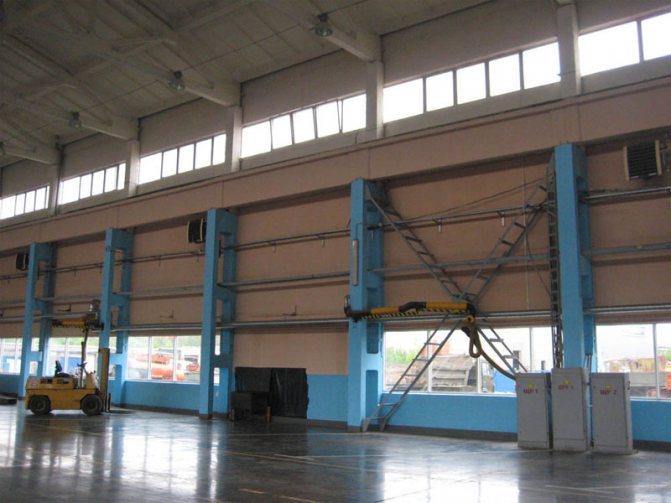

It is used only in small warehouses with low ceilings due to the reasons already described above; Also, this system is not very popular due to the complexity of installation, as well as the large amount of occupied space, which does not allow using the warehouse area with maximum efficiency (this mainly concerns retail warehouses and bases where rack structures are used).
Water heating
The water central heating system consists of a heating point, highways, separate risers and branches with heating devices. Central water heating systems are distinguished:
- by the temperature of the coolant (water) - 95 ... 105 ° С and more than 105 ° С;
- according to the scheme of connecting pipes with heating devices - one-pipe and two-pipe;
- by the position of the pipes connecting the heating devices - vertical and horizontal;
- by the location of the highways - with upper wiring and with lower wiring;
- in the direction of water movement.
The choice of a hot water heating system consists in setting the parameters of the water, the hydraulic pressure in the system, as well as in the choice of the type of heating devices and the design of the system. The advantage of a water heating system over a steam one for warehouses is that it provides an even heating of heating devices with a low temperature, which does not cause excessive dryness of the air in the premises, which harms many types of goods stored in warehouses.
Air heating systems
Much more popular is the air heating of the warehouse, which was first used in the seventies of the last century and is being effectively improved to this day. These systems do not interact with any external sources, and the heating of the air in the room is provided by the operation of heat generators and heaters - water and steam.
The heated air enters through the box-shaped collectors to those rooms where it is necessary to maintain a certain temperature regime. To reduce or increase the air flow, special adjustable flaps or louvers are used.
This method also has some disadvantages, although there are fewer of them than the previous system.Nevertheless, the air system is one of the most commonly used in warehouse heating due to its ease of installation and relatively low cost of equipment.
Outcomes
No heating system will be effective without insulation of the warehouse. The best insulation is polyurethane foam (PPU). There are three options for heating the warehouse: air, electric, and water. Air heating by heat pumps is convenient, it makes it possible to control the temperature and humidity of the air, the speed of circulation. The disadvantage is high upfront costs. Electric heating is expensive to operate, but the devices can be moved to any other place. Water systems are a classic, they are found most often.
The group is ready to implement complex solutions for the arrangement of internal engineering systems and building networks. We provide a guarantee for the equipment purchased from us and all installation work!
We are waiting for your call by phone: +7(495) 745-01-41
Our email
About us, Reviews, Our objects, Contacts
See further
- Heating systems. Heat supply of buildings
- What is your object?
Radiant heating systems
Radiant heating is even more economical and easy to install and use than air heating. Infrared heaters do not generate dust and do not dry the air. The principle of operation of such a system is extremely simple - like the rays of the sun, the elements of this system do not heat the air, but the objects at which they are directed - the floor, walls, objects - and these, in turn, give off part of the heat received to the environment.
This is most convenient in cases where heating of a certain small area is required; the luminaires themselves are easily mounted at a height of 1.5-2 meters from the floor, and the concentration of emitted heat particles can be adjusted.
Depending on the microclimate maintained inside the warehouse, "light" and "dark" infrared heaters are used. The release of heat in them is facilitated by natural or liquefied gas. Heaters can either be installed directly into walls or wall niches, or be part of entire radiant panels located along the entire length of the building. Portable models are also produced, which are used in conditions of impossibility of installing the heating system. Depending on their dimensions, they can be either manual or placed on special wheeled units.
"Light" infrared heaters are characterized by extremely high temperatures - the surface of the burner can heat up to 900 degrees. "Dark" ones provide less heating - only up to 500 degrees - but at the same time they are equipped with special reflectors that allow dissipating heat particles and, thereby, providing heating of much larger areas. They also differ in design - the former are solid ceramic tiles (it heats up and produces infrared radiation), while the latter are a pipe structure with an external heat-resistant coating, inside which the gas combustion process takes place.
The most versatile type of infrared heaters are radiant panels, which are widespread in most standard storage warehouses and are standard fire safety codes. It is also convenient to use them for air conditioning - when connecting a steam generator. At the same time, steam can be heated up to almost 200 degrees, which contributes to a significant increase in the rate of air exchange inside the room.
Thus, we can say that today radiant heaters of both types are the best options for heating systems - efficient, economical and convenient. However, the following restrictions on the use of these units should be mentioned:
- inability to use heating panels at a height below 4 meters.Otherwise, the heating temperature of the area will be too high - moreover, such intense radiation will have a bad effect on the health of people passing under them;
- in rooms with increased fire safety requirements. This applies to warehouses of fuels and lubricants and other flammable liquids, petroleum products, oils, etc .;
- in rooms where goods are stored that are sensitive to infrared radiation.
Technical standards
Various SNiP, PPB and PUE regulate the rules for the installation of heating systems in warehouses, but only a specialist can understand the jungle of technical terminology. Here are some excerpts from the regulations:
- SNiP 2.11.01-85, clause 5.3 says that it is allowed to install air heating or combine air heating with local heating devices in warehouses.
- PUE clause 7.4.25: if in a fire hazardous zone of any class (which includes warehouses) heating is possible only with the help of electric heating devices, then the heating surfaces must be protected from contact with flammable substances. A stand made of non-combustible material should be arranged under the devices. For protection, fireproof screens are used that do not allow thermal radiation to pass through. It is prohibited to use electric heating devices in fire hazardous areas of warehouses, museums, archives, libraries, etc. An exception is specially designed rooms, for example, a dining room.
- SNiP 41-01-2003 clause 7.9.1. It is not allowed to place heating equipment in serviced warehouses of categories A, B, B1-B4. In terminals of categories B2, B3, B4, it is possible to place heating equipment if several conditions are met: the warehouse must be equipped with an automatic fire alarm, which can turn off the equipment in the event of a fire.
- heating devices must have a degree of protection not lower than IP-54;
- SNiP 41-01-2003 clause 12.2. Electrical receivers for heating systems must be of the same category as electrical receivers of engineering and technological equipment of the warehouse.
In general, all the standards speak about the device of gas heating for warehouses, but the use of electrical equipment is also allowed. The electric boiler must be installed in a separate room or in an annex with walls made of non-combustible materials.
Air-thermal curtains
Air curtains are required to separate zones with different temperature conditions. The equipment is mounted in the aperture of doors, windows, gates. The curtain is formed by the movement of a high-speed air flow. It is a kind of invisible barrier that does not allow warm air to escape and does not let cold air in from outside.In addition, the air curtain isolates the warehouse from exhaust gases, dust and other negative phenomena without interfering with the movement of special vehicles.
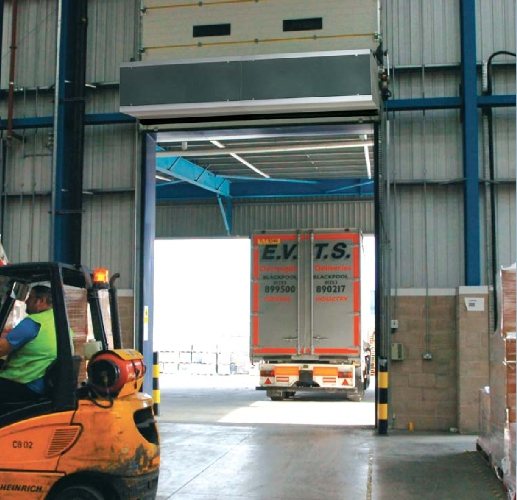

The curtain width is 0.6-2.5 meters. In wider openings, several devices are mounted close to each other. When calculating the heat curtain, the following factors are taken into account:
- the maximum temperature of the supplied air is 50 ° С at the entrance;
- temperature of air entering from outside 5-14 ° С;
- air speed no more than 8 m / s at the entrance and no more than 25 m / s at technological openings and gates;
- installation of thermal curtains is justified for entrance doors without vestibules that are opened five or more times a day or for 40 minutes per shift.
Steam systems
The heat carrier is dry saturated steam with a temperature not exceeding 130 ° С. The system can be open-loop, when the condensate is transferred to the heat exchanger by a pump, or closed, when the condensate moves by gravity. Main advantages:
- minimal heat loss in heat exchangers;
- fast heating of radiators and other heating devices;
- low inertia;
- the possibility of heating multi-storey buildings;
- compactness of equipment;
- low hydrostatic pressure in the system.
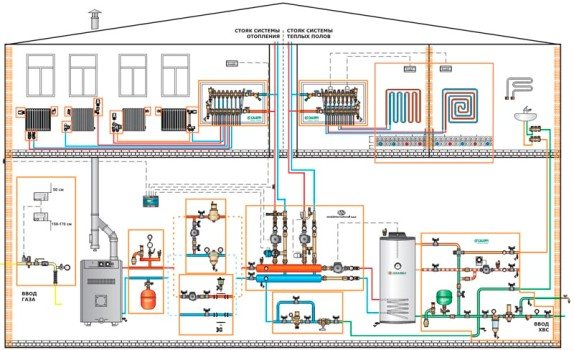

Disadvantages:
- high heat losses in steam lines, as a result - a decrease in efficiency;
- noisiness;
- you cannot make the temperature of the coolant below 100 ° C;
- intensive corrosion of the metal elements of the circuit.
Steam heating is permitted for terminals with non-flammable and non-toxic dust, non-flammable and non-flammable vapors and gases. Steam lines are installed separately from the ventilation and air conditioning system.
Water infrared panels
Today, another very profitable way is known, with the help of which it is possible to equip the heating of a hangar or any other large utility room - the use of water IR panels.
In this case, the heat transfer fluid is heated up to 160 ° C and enters the radiating tubes located under the ceiling. The infrared radiator effectively dissipates heat throughout the entire volume of the heated room. Thus, the equipment operates not on the convective, but on the radiant principle.
The uniqueness of such equipment lies in the fact that the air in the room is not heated. Various types of surfaces are subject to heating, including the surface of equipment, goods, shelving, walls, floors, ceilings, and even people in the room.
With the help of IR water panels, it is possible to effectively organize the heating of the workshop in which welding, carpentry and other production work is performed.
In this case, the purpose of the method is not to heat the room itself or raw materials, but to provide heat to the working personnel.
PVC pipe
| PVC pipe 160х3.6х1,000m | PC | 264,37 |
| PVC pipe 160х3.6х2,000m | PC | 503,75 |
| PVC pipe 160х3.6х3,000m | PC | 775,41 |
| PVC pipe 50х3,2х0,500m | PC | 42,30 |
| PVC pipe 50х3,2х1,000m | PC | 70,68 |
| PVC pipe 50х3.2х2,000m | wt | 131,85 |
| PVC pipe 110х2,7х1,000m | PC | 104,87 |
| PVC pipe 110х2,7,000m | PC | 195,12 |
| PVC pipe 110х2,7,000m | PC | 298,25 |
Calculating the cost of heating
Heating system repair cost
Water supply installation cost
Engineering systems: heating water supply:
- Radiant warehouse heating systems Radiant heating is even more economical and simple to install and use than air heating. Infrared heaters do not generate dust and do not dry the air. The principle of operation of such a system is extremely simple - like the rays of the sun, the elements of this system are heated ...
- Warehouse heating methods You can order heating of a warehouse, hangar, workshop, production or industrial premises with turnkey installation by calling DESIGN PRESTIGE Holding SpetsStroyAlyans LLC by phone in Moscow +7 (495) 295-55-06 - MSC Company Group Call around the clock ...
- Warehouse heating You can order heating of a warehouse, hangar, workshop, production or industrial premises with a turnkey installation by calling DESIGN PRESTIGE LLC in Moscow +7 (495) 295-55-05 - SpetsStroyAlyans Holding MSC Company Group Call around the clock ...
- Types of warehouse heating You can order heating of a warehouse, hangar, workshop, production or industrial premises with a turnkey installation by calling DESIGN PRESTIGE Holding SpetsStroyAlyans LLC by phone in Moscow +7 (495) 295-55-06 - MSC Company Group Call around the clock ...
- Forced heating of a warehouse You can order forced heating of a warehouse, hangar, workshop, production or industrial premises with turnkey installation by calling in Moscow: +7 (495) 744-67-74 - DESIGN PRESTIGE Holding SpetsStroyAlyans MSC Company Group Call ...
- Natural heating of a warehouse You can order natural heating of a warehouse, hangar, workshop, production or industrial premises with turnkey installation by calling in Moscow: +7 (495) 744-67-74 - DESIGN PRESTIGE Holding SpetsStroyAlliance MSC Company Group Call ...
- Classification of warehouse heating
- Estimates for the installation of gas-air heating of a warehouse and installation of an electric gas generator Local estimates for the installation of a gas-air heating of a warehouse and installation of an electric gas generator, including: punching holes in brick walls for water and gas pipes manually, pulling steel pipes into a case, sealing with bitumen and a strand of the ends of the case, laying pipelines from steel non-galvanized water and gas pipelines ...
- Centralized heating of a warehouse You can order centralized heating of a warehouse, hangar, workshop, production or industrial premises with turnkey installation by calling in Moscow: +7 (495) 744-67-74 - DESIGN PRESTIGE Holding SpetsStroyAlliance MSC Company Group Call ...
- Water heating of a warehouse You can order heating of a warehouse, hangar, workshop, production or industrial premises with turnkey installation by calling DESIGN PRESTIGE Holding SpetsStroyAlyans LLC by phone in Moscow +7 (495) 295-55-06 - MSC Company Group Call around the clock ...
- Steam heating of a warehouse You can order heating of a warehouse, hangar, workshop, production or industrial premises with turnkey installation by calling DESIGN PRESTIGE Holding SpetsStroyAlyans LLC +7 (495) 295-55-06 - MSC Company Group Call around the clock ...
- Heating of a warehouse with a heating point You can order heating of a warehouse, hangar, workshop, production or industrial premises, installation of a heating point with turnkey installation by calling DESIGN PRESTIGE Holding SpetsStroyAlyans LLC by phone in Moscow +7 (495) 295-55-06 - MSC Company ...
- Industrial heating systems, heating of industrial buildings You can order heating of a warehouse, hangar, workshop, production or industrial premises, installation of a heat point with turnkey installation by calling DESIGN PRESTIGE Holding SpetsStroyAlyans LLC by phone in Moscow +7 (495) 295-55 -06 - MSC Company ...
- Heating of hangars by a heating point You can order heating of a warehouse, hangar, workshop, production or industrial premises, installation of a heating point with turnkey installation by calling DESIGN PRESTIGE Holding SpetsStroyAlyans LLC by phone in Moscow +7 (495) 295-55-06 - MSC Company ...
- Thermal insulation of warehouses and hangars You can order heating of a warehouse, hangar, workshop, production or industrial premises with turnkey installation by calling in Moscow: +7 (495) 744-67-74 - DESIGN PRESTIGE Holding SpetsStroyAlyans MSC Company Group Call around the clock ...
- Estimates for the installation of a unit for commercial metering of heat energy of heating MOU SOSH Local estimated calculation for the installation of a unit for commercial metering of thermal energy of heating, including: disassembly of pipelines from water and gas pipes, laying of heating pipelines from steel water and gas pipes not galvanized, ball valve all-welded flanged Ф 15 mm, installation of filters installation of pressure gauges with a three-way valve, bosses, fittings ...
- Estimates for the installation of a commercial metering unit for heat energy from heating (USNO) Local estimated calculation for the installation of a unit for commercial metering of heat energy for heating MOU SOSH, at prices of 2 sq. 2011 USNO, including: plumbing work, disassembly of pipelines from water and gas pipes, laying of heating pipelines from steel water and gas non-galvanized, all-welded flanged ball valve F ...
- Heating systems and boilers for heating industrial buildings Heating systems and boilers for heating industrial buildings Heating of industrial buildings has its own characteristics and requires a special approach to the issue, and individual in each case. The sources of heat for various heating methods are most often industrial boilers operating on different ...
- Installation of a heating system in the country Previously, most country houses at the end of the season were tightly closed for the winter. And the Soviet proverb about the fact that one move is equal to two repairs, perfectly illustrated the departure of the average family to the country in the spring. Old wood stoves, potbelly stoves, electric heaters, because of which ...
- Welding of metal heating pipes When installing heating pipes, it is often necessary to connect them by welding. Of course, in some cases, a threaded connection may also be suitable, but the percentage of this method is much less. Welding metal heating pipes As for welding steel pipes, this method has several ...
Previous post Warehouse heating methods
Next post Radiant warehouse heating systems

